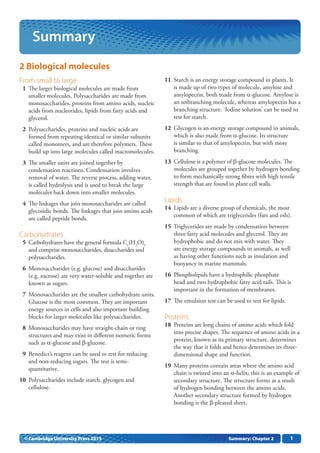More Related Content
Similar to Summary ch02 (20)
More from ceciliaadem (20)
Summary ch02
- 1. 11
2 Biological molecules
Summary
11 Starch is an energy storage compound in plants. It
is made up of two types of molecule, amylose and
amylopectin, both made from α-glucose. Amylose is
an unbranching molecule, whereas amylopectin has a
branching structure. ‘Iodine solution’ can be used to
test for starch.
12 Glycogen is an energy storage compound in animals,
which is also made from α-glucose. Its structure
is similar to that of amylopectin, but with more
branching.
13 Cellulose is a polymer of β-glucose molecules. The
molecules are grouped together by hydrogen bonding
to form mechanically strong fibres with high tensile
strength that are found in plant cell walls.
Lipids
14 Lipids are a diverse group of chemicals, the most
common of which are triglycerides (fats and oils).
15 Triglycerides are made by condensation between
three fatty acid molecules and glycerol. They are
hydrophobic and do not mix with water. They
are energy storage compounds in animals, as well
as having other functions such as insulation and
buoyancy in marine mammals.
16 Phospholipids have a hydrophilic phosphate
head and two hydrophobic fatty acid tails. This is
important in the formation of membranes.
17 The emulsion test can be used to test for lipids.
Proteins
18 Proteins are long chains of amino acids which fold
into precise shapes. The sequence of amino acids in a
protein, known as its primary structure, determines
the way that it folds and hence determines its three-
dimensional shape and function.
19 Many proteins contain areas where the amino acid
chain is twisted into an α-helix; this is an example of
secondary structure. The structure forms as a result
of hydrogen bonding between the amino acids.
Another secondary structure formed by hydrogen
bonding is the β-pleated sheet.
From small to large
1 The larger biological molecules are made from
smaller molecules. Polysaccharides are made from
monosaccharides, proteins from amino acids, nucleic
acids from nucleotides, lipids from fatty acids and
glycerol.
2 Polysaccharides, proteins and nucleic acids are
formed from repeating identical or similar subunits
called monomers, and are therefore polymers. These
build up into large molecules called macromolecules.
3 The smaller units are joined together by
condensation reactions. Condensation involves
removal of water. The reverse process, adding water,
is called hydrolysis and is used to break the large
molecules back down into smaller molecules.
4 The linkages that join monosaccharides are called
glycosidic bonds. The linkages that join amino acids
are called peptide bonds.
Carbohydrates
5 Carbohydrates have the general formula Cx
(H2
O)y
and comprise monosaccharides, disaccharides and
polysaccharides.
6 Monosaccharides (e.g. glucose) and disaccharides
(e.g. sucrose) are very water-soluble and together are
known as sugars.
7 Monosaccharides are the smallest carbohydrate units.
Glucose is the most common. They are important
energy sources in cells and also important building
blocks for larger molecules like polysaccharides.
8 Monosaccharides may have straight-chain or ring
structures and may exist in different isomeric forms
such as α-glucose and β-glucose.
9 Benedict’s reagent can be used to test for reducing
and non-reducing sugars. The test is semi-
quantitative.
10 Polysaccharides include starch, glycogen and
cellulose.
© Cambridge University Press 2013 Summary: Chapter 2
- 2. 22
20 Further folding of proteins produces the tertiary
structure. Often, a protein is made from more than
one polypeptide chain. The association between the
different chains is the quaternary structure of the
protein. Tertiary and quaternary structures are very
precise and are held in place by hydrogen bonds,
disulfide bonds (which are covalent), ionic bonds
and hydrophobic interactions.
21 Proteins may be globular or fibrous. A molecule of a
globular protein, for example haemoglobin, is roughly
spherical. Most globular proteins are soluble and
metabolically active. Haemoglobin contains a non-
protein (prosthetic) group, the haem group, which
contains iron. This combines with oxygen. A molecule
of a fibrous protein, for example collagen, is less
folded and forms long strands. Fibrous proteins are
insoluble. They often have a structural role. Collagen
has high tensile strength and is the most common
animal protein, being found in a wide range of tissues.
22 Biuret reagent can be used to test for proteins.
Water
23 Water is important within plants and animals, where
it forms a large part of the mass of each cell. It is also
an environment in which organisms can live.
24 As a result of extensive hydrogen bonding, water has
unusual properties that are important for life: it is
liquid at most temperatures on the Earth’s surface; its
highest density occurs above its freezing point, so that
ice floats and insulates water below from freezing air
temperatures; it acts as a solvent for ions and polar
molecules, and causes non-polar molecules to group
together; it has a high surface tension, which affects
the way it moves through narrow tubes and forms
a surface on which some organisms can live. Water
can also act as a reagent inside cells, as in hydrolysis
reactions and in photosynthesis as a source of
hydrogen.
Summary: Chapter 2 © Cambridge University Press 2013
